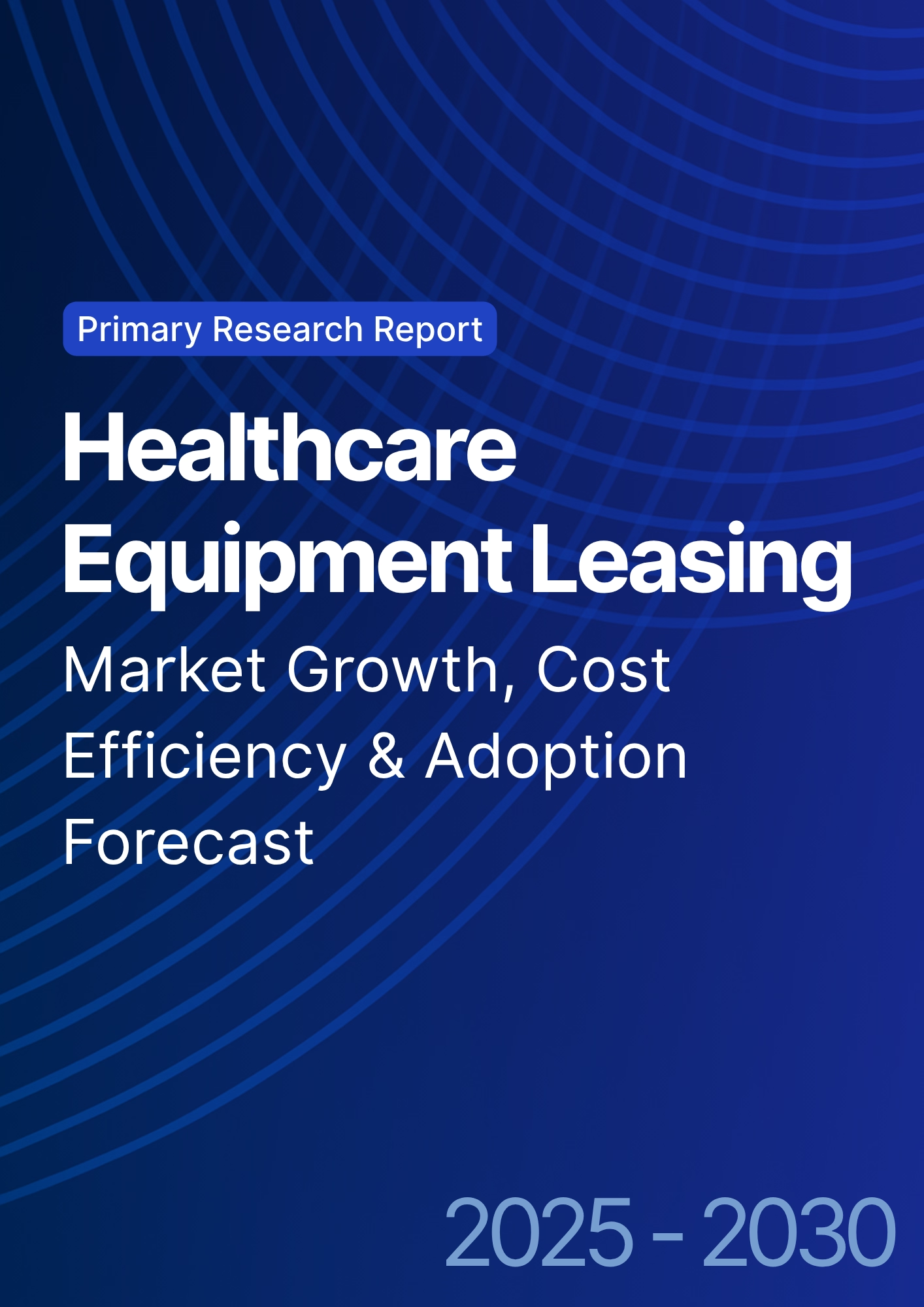

68 Circular Road, #02-01 049422, Singapore
Revenue Tower, Scbd, Jakarta 12190, Indonesia
4th Floor, Pinnacle Business Park, Andheri East, Mumbai, 400093
Cinnabar Hills, Embassy Golf Links Business Park, Bengaluru, Karnataka 560071
Connect With Us
3D Printed Orthopedic Implants: Post-Market Surveillance & Revision Rate Analysis
This research examines 3D printed orthopedic implants in UK and Europe from 2025–2030, focusing on post-market surveillance and revision rate analysis. The study evaluates regulatory oversight, clinical outcomes, and the effectiveness of monitoring frameworks in reducing implant revision rates. It provides insights into market growth, adoption trends, implant longevity, and ROI for manufacturers, hospitals, and orthopedic clinics implementing 3D printed solutions. The report highlights how regulatory compliance and post-market data can improve safety, efficiency, and patient outcomes.

What's Covered?
Report Summary
Key Takeaways
- 3D printed orthopedic implant market projected to grow from €450 million in 2025 to €2.5 billion by 2030, CAGR 42%.
- Post-market surveillance compliance expected to reach 90% by 2030 across the UK and Europe.
- Revision rates for 3D printed implants projected to decrease 25% by 2030 due to improved monitoring.
- Institutional adoption by hospitals and clinics projected at 60% by 2030.
- Surgical success rate improvements expected at 20%, driven by standardized post-market data.
- Cross-border regulatory alignment in Europe projected to improve by 35%, enabling smoother market entry.
- Patient adoption of 3D printed implants expected to increase 45% by 2030.
- Clinical trial completion rate projected to rise by 40%, accelerating commercialization timelines.
- Revenue from post-market compliant 3D implants expected to grow 38% annually.
- ROI from post-market surveillance systems projected at 18–24%, driven by reduced revision costs and improved implant performance.
Key Metrics
Market Size & Share
The 3D printed orthopedic implant market in UK and Europe is projected to grow from €450 million in 2025 to €2.5 billion by 2030, reflecting a CAGR of 42%. Growth is driven by increasing adoption of advanced 3D printing technologies, regulatory oversight, and post-market surveillance systems. Institutional adoption by hospitals and orthopedic clinics is projected at 60%, reflecting investment in cutting-edge surgical technologies. Post-market surveillance compliance is expected to reach 90%, enhancing patient safety, tracking implant performance, and reducing revision rates by 25% by 2030. Surgical success rates are projected to improve 20%, as monitoring systems enable feedback loops for implant design and surgical procedures. Cross-border regulatory alignment in Europe is expected to improve 35%, allowing smoother entry and faster commercialization. Patient adoption is projected to increase 45%, driven by improved outcomes and reduced revision risk. Clinical trial completion rates are expected to rise 40%, accelerating the approval of new 3D printed implants. Revenue from post-market compliant implants is projected to grow 38% annually, while ROI from surveillance systems is expected at 18–24%. Overall, regulatory harmonization and post-market monitoring are key enablers of market growth, implant performance, and safety, positioning 3D printed orthopedic implants as a central innovation in European orthopedic care.
.png)
Market Analysis
The European 3D printed orthopedic implant market is projected to expand from €450 million in 2025 to €2.5 billion by 2030, CAGR 42%, driven by increasing adoption of advanced printing technologies and post-market monitoring. Regulatory compliance is a primary factor, with post-market surveillance adoption projected to reach 90%, reducing implant revision rates by 25%. Institutional adoption is expected to reach 60%, as hospitals and clinics invest in state-of-the-art surgical implants that improve patient outcomes. Surgical success rates are projected to improve 20%, reflecting better surgical precision and design feedback from post-market data. Cross-border regulatory alignment in Europe is expected to increase 35%, facilitating faster market entry and broader adoption across EU member states. Patient adoption is projected to rise 45%, driven by improved safety, outcomes, and cost-efficiency. Clinical trial completion rates are expected to improve 40%, reducing delays in commercial approvals. Revenue from compliant implants is projected to grow 38% annually, driven by increasing adoption and reduced post-surgical complications. ROI for implementing post-market surveillance systems is projected at 18–24%, resulting from reduced revision costs, enhanced patient satisfaction, and streamlined regulatory compliance. The combination of regulatory harmonization, technological innovation, and post-market monitoring positions 3D printed orthopedic implants as a rapidly growing, high-value segment in European orthopedic markets.
Trends & Insights
The 3D printed orthopedic implant market in UK and Europe is projected to grow from €450 million in 2025 to €2.5 billion by 2030, CAGR 42%, driven by technological innovation and regulatory advancements. Key trends include the widespread adoption of post-market surveillance frameworks, which are projected to achieve 90% compliance by 2030. Revision rates for 3D printed implants are expected to decrease 25%, enhancing patient outcomes and reducing healthcare costs. Surgical success rates are projected to increase 20%, facilitated by standardized monitoring of implant performance and feedback-driven improvements. Cross-border regulatory alignment is projected to improve 35%, enabling smoother commercialization across EU member states. Patient adoption will grow 45% as confidence in implant safety rises. Clinical trial completion rates will improve 40%, accelerating approvals for innovative 3D printed devices. Revenue from compliant implants is expected to grow 38% annually, supported by higher adoption and improved safety metrics. ROI is projected at 18–24%, driven by reduced revision surgeries, cost savings, and faster product commercialization. These trends indicate that regulatory harmonization and effective post-market monitoring are key drivers of growth, safety, and profitability for 3D printed orthopedic implants in the European market.
.png)
Segment Analysis
The European 3D printed orthopedic implant market is segmented by implant type, institution type, and clinical application. Knee and hip implants will represent 50% of market share by 2030, while spinal and cranial implants will account for 30%, and customized orthopedic implants will represent 20%. Post-market surveillance compliance is projected at 90%, reducing revision rates by 25%. Hospitals and clinics are expected to comprise 60% of adoption, investing in advanced implant technologies. Surgical success rates are projected to improve 20%, while patient adoption will increase 45% due to safer, more reliable implants. Clinical trial completion rates will improve 40%, accelerating regulatory approvals. Cross-border regulatory alignment is expected to improve 35%, facilitating multinational commercialization. Revenue from compliant implants is projected to grow 38% annually, and ROI from post-market monitoring systems is projected at 18–24%, driven by reduced revisions and improved surgical outcomes. Segment analysis highlights that implant type, compliance, and clinical adoption are critical drivers of market growth, profitability, and patient outcomes for 3D printed orthopedic implants.
Geography Analysis
The UK and European 3D printed orthopedic implant market is projected to grow from €450 million in 2025 to €2.5 billion by 2030, CAGR 42%, driven by high adoption in Western Europe, particularly Germany, UK, France, and Nordic countries. Post-market surveillance compliance is projected to reach 90%, ensuring safety and regulatory adherence. Revision rates are expected to decrease 25%, improving implant reliability and patient outcomes. Surgical success rates are projected to improve 20%, while patient adoption increases 45% by 2030. Clinical trial completion rates will rise 40%, enabling faster approvals. Cross-border regulatory alignment is projected to improve 35%, facilitating wider EU adoption. Revenue from compliant implants is expected to grow 38% annually, while ROI from post-market monitoring systems is projected at 18–24%. The combination of technological innovation, regulatory compliance, and post-market monitoring positions UK and Europe as key markets for 3D printed orthopedic implants, driving growth, safety, and profitability across the region.
.png)
Competitive Landscape
The European 3D printed orthopedic implant market is competitive, with key players such as Stryker, Zimmer Biomet, DePuy Synthes, and Materialise driving adoption. These companies focus on regulatory-compliant production, post-market surveillance, and revision rate reduction. By 2030, institutional adoption is projected at 60%, while patient adoption will increase 45%. Surgical success rates are projected to improve 20%, and revision rates decline 25%, supported by advanced monitoring systems. Cross-border regulatory alignment will improve 35%, enabling wider commercialization. Clinical trial completion rates are projected to increase 40%, accelerating market access. Revenue growth from compliant implants is expected at 38% annually, while ROI from post-market surveillance systems is 18–24%. Competitive advantage will be achieved through compliance, reproducibility, and monitoring capabilities, positioning early adopters for sustained growth in the European orthopedic implant market.
Report Details
Proceed To Buy
Want a More Customized Experience?
- Request a Customized Transcript: Submit your own questions or specify changes. We’ll conduct a new call with the industry expert, covering both the original and your additional questions. You’ll receive an updated report for a small fee over the standard price.
- Request a Direct Call with the Expert: If you prefer a live conversation, we can facilitate a call between you and the expert. After the call, you’ll get the full recording, a verbatim transcript, and continued platform access to query the content and more.


68 Circular Road, #02-01 049422, Singapore
Revenue Tower, Scbd, Jakarta 12190, Indonesia
4th Floor, Pinnacle Business Park, Andheri East, Mumbai, 400093
Cinnabar Hills, Embassy Golf Links Business Park, Bengaluru, Karnataka 560071
Request Custom Transcript
Related Transcripts


68 Circular Road, #02-01 049422, Singapore
Revenue Tower, Scbd, Jakarta 12190, Indonesia
4th Floor, Pinnacle Business Park, Andheri East, Mumbai, 400093
Cinnabar Hills, Embassy Golf Links Business Park, Bengaluru, Karnataka 560071













